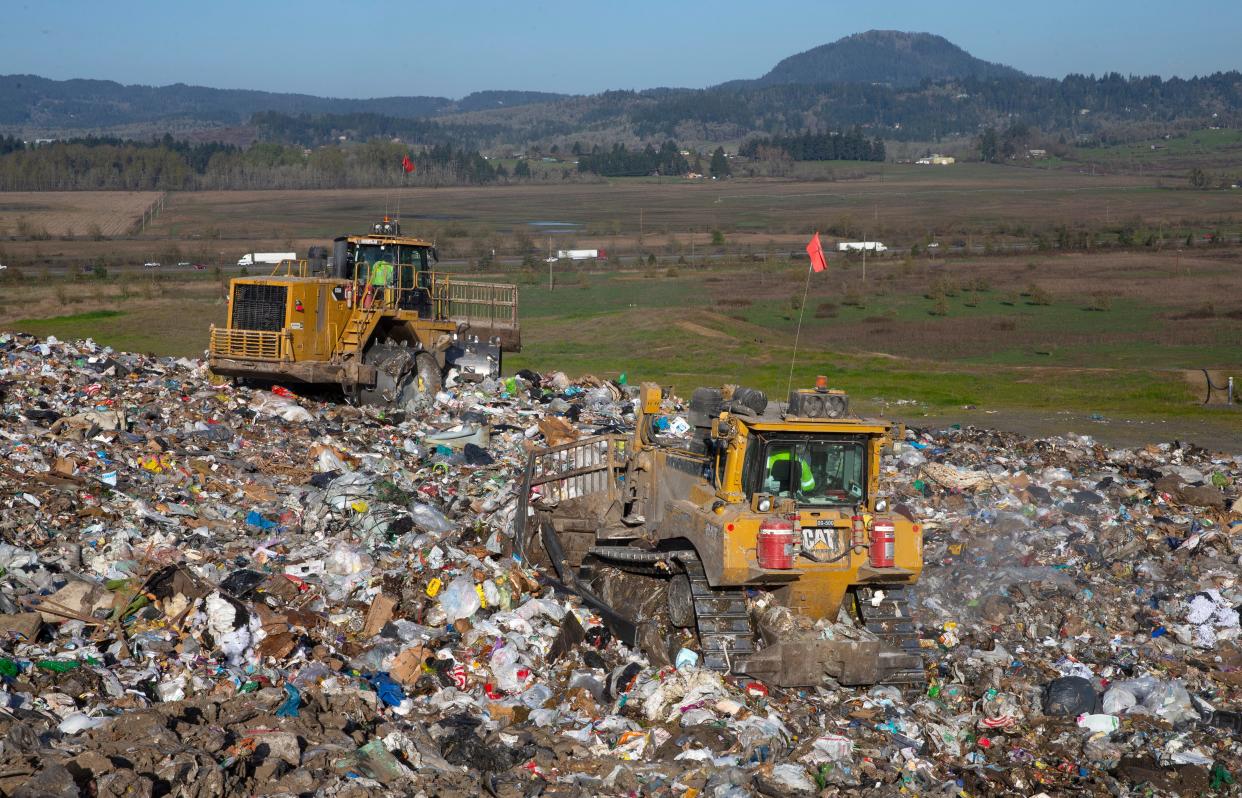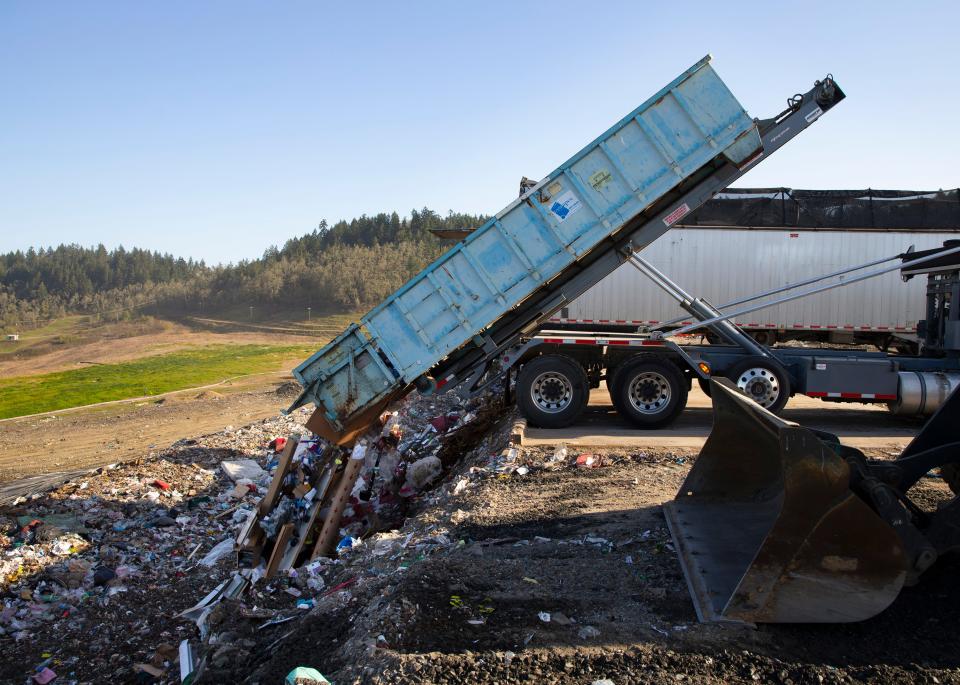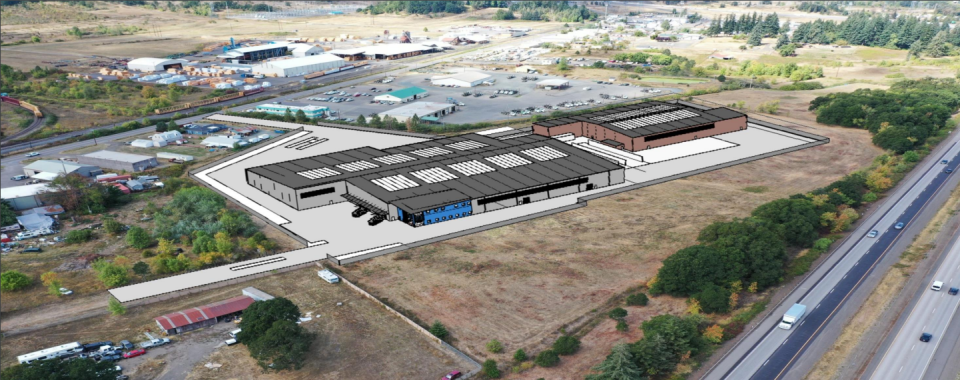Lane County says proposed waste processing facility could divert 80,000 tons of trash

Corrections and Clarifications: This article has been updated to correct the projected annual operating cost of the proposed waste management facility.
A proposed waste management facility to process residential garbage, commingled recycling and organic waste before sending it to the Short Mountain Landfill, would divert more than 80,000 tons of trash a year from the landfill, according to Lane County.
But some residents and businesses who use the landfill contend the cost of the proposed facility is too steep and would hurt them due to increased garbage rates.
The Short Mountain Landfill is the only landfill in Lane County. County staff said they believe the proposed Material and Energy Recovery Facility would not only preserve the life of the landfill but reduce its carbon footprint.

Lane County waste diversion
In 2015, the Oregon Legislature passed Senate Bill 263, which directed counties to set goals for garbage diversion rates, the portion of waste that doesn't go into a landfill. Lane County commissioners set a goal of 63%.
In the time since, the county's diversion rate dropped from 59.1% in 2014 to 49.7% in 2021 according to Department of Environmental Quality data.
Part of this difference is because SB 263 changed the state formula that previously awarded credits for having waste prevention, reuse and composting programs. Applying the current formula to 2014 gives Lane County a 53.1% diversion rate for that year.

Integrated Material and Energy Recovery Facility
In 2022, Lane County issued a request for proposals for ways to increase the amount of garbage diverted from the landfill, and has been advancing with a bid from Eugene-based waste processor Bulk Handling Systems.
The proposed facility would be located in Goshen next to a trucking site for logging company Weyerhaeuser and M&N Electric Motor Repairs and Sales.
Lane County and BHS said the facility would allow the county to:
Turn organic waste into renewable natural gas through a process called anaerobic digestion. Renewable natural gas is a resource some have praised as a way to put to use methane that would otherwise be released from a landfill. Others have criticized it as a tool that natural gas companies have used to argue against electrification.
Recycle materials currently excluded such as plastic tubs and film
Create 190 jobs during construction and 65 ongoing jobs during operation
Let Lane County take recycling from other counties. The county currently sends some recycling to the Portland area.
Overall, it would raise Lane County's recovery rate to 70%, the county said.
"It's an exciting project because it's multiple projects in one," said Lane County public works director Dan Hurley. "It's a climate project. It's an economic development project. It's an infrastructure project because it will extend the life of the landfill … The jobs in the community, extending this resource for a whole generation … outweigh those smaller incremental costs" in rate increases.
Lane County waste management division manager Jeff Orlandini told The Register-Guard the landfill has about 70 years of life left. This is half of what the county projected five years ago. Orlandini said the difference is mostly due to the landfill's seismic upgrades, which reduced capacity.
Lane County staff were especially optimistic about diverting more food waste. In 2019, food waste made up 18% of the county's total and the county lacks local options for food waste diversion. The landfill currently produces 77% of the county government's emissions because of decaying waste, much of it food, and the diversion from the landfill would translate to an annual reduction of 100,000 tons of carbon dioxide equivalent, the county says.
BHS has built waste processors in multiple countries. Most operate on a smaller scale than the one proposed for Goshen, which would have both mixed materials processing and anaerobic digestion.
The closest analogy is in San Jose, California, where BHS subsidiary Zero Waste Energy operates both an anaerobic digestor and a separate company GreenWaste operates a materials recovery facility built by BHS. The GreenWaste facility opened in 2008 and the Zero Waste facility opened in 2013.
Those facilities, along with a second recovery facility, and a unique system of garbage collection rates, earned San Jose national recognition from the Environmental Protection Agency for a 74% diversion rate.
How construction for the Lane County facility will be paid has not been determined. BHS suggested the projected $150 million construction be split between $100 million from the company, $35 million from Lane County, and $15 million from a state tax credit.
Lane county employees presented the plan to county commissioners last month, and to Springfield city councilors Nov. 20. They've received praise from environmentalists and criticism from councilors and others in the waste disposal business, primarily due to garbage rates.
"When our county commissioners approve this waste management facility, they will create the infrastructure to increase our county's recycling rates, extend the life of our public landfill, and produce nearly 1 million gallon equivalents every year of renewable natural gas," Beyond Toxics Executive Director Lisa Arkin said in a press release.
IMERF and garbage rates
Lane County Waste Management is run by the county but does not receive county tax money. BHS estimates running the facility will cost $9 million annually, a cost that would be passed along to ratepayers.
Lane County updated its cost projections and said tipping fees (which make up 20% of a residential garbage bill and 30% of a commercial bill) would increase 8% per year for the first two years and 6% for the subsequent years, plus inflation.
"It just seems like a very large amount of money that you're looking at spending for this self-imposed recovery rate that you're looking for," said Springfield city councilor Victoria Doyle. "It is a big deal. You're raising rates and you're doing it consecutively over a period of time like putting a frog in a pot of water and slowly turning up the heat."
Garbage collection company Sanipac translated Lane County's previously projected rate increases would be between $2.74 per month for a small home to $6,655.55 per month for a large nonprofit at the end of the six years.
Previous estimates of the Integrated Material and Energy Recovery Facility's effect on garbage rates:
Business | Current Monthly Bill | Projected Monthly Bill | $ Increase | % Increase |
Small home (35 gallons of trash per week) | $26.15 | $28.89 | $2.74 | 10.48% |
Medium home (65 gallons of trash per week) | $45.35 | $50.44 | $5.09 | 11.22% |
Large home (95 gallons of trash per week) | $55.96 | $63.41 | $7.45 | 13.31% |
Sandwich/Coffee shop | $275.31 | $315.41 | $40.10 | 14.57% |
Restaurant | $723.11 | $832.84 | $109.73 | 15.17% |
Apartment complex | $2,659.08 | $3,097.99 | $438.91 | 16.51% |
Small high school | $2,022.74 | $2,461.55 | $438.91 | 21.70% |
Large high school | $3,076.25 | $3,666.03 | $589.78 | 19.17% |
Small hospital | $5,838.96 | $7,690.30 | $1,851.34 | 31.17% |
Large hospital | $15,871.23 | $21,089.24 | $5,218.01 | 32.88% |
Industrial business | $11,325.02 | $15,439.22 | $4,114.20 | 36.33% |
Large construction project | $15,408.31 | $20,750.49 | $5,342.18 | 34.67% |
Large non-profit | $20,054.35 | $26,709.90 | $6,655.55 | 33.19% |
Lane County and BHS have argued the IMERF will decrease rates in the long term, because when Short Mountain reaches capacity ratepayers will have to pay to either build a new landfill or pay to ship waste to a landfill in another county.
"For those concerned about costs, you only need to look to Portland to see how much it will cost us in the future," said BHS CEO Steve Miller. "The only viable option is the Arlington landfill in Eastern Oregon – 250 miles away from Lane County. Portland pays 60% more in trash costs than we do in Lane County."
Opponents of the project also argued that while Lane County's recovery rate is declining, it remains the highest in Oregon and there are cheaper ways to raise it, such as with the proposed replacement for the Glenwood Transfer Station, and that the facility's job creation is overstated because of jobs that would be lost elsewhere.
"I believe it'll impact my job in the recycling industry," Travis Sinclair of the International Paper recycling plant told Springfield city councilors on Nov. 20. "We have been collecting recyclables in this community (for) years and sending the material into the Springfield mill. … It provides many living wage jobs here in our area."
The Emerald People's Utility District, the public electric utility serving most of rural central Lane County is similarly opposed to the project. EPUD currently diverts some methane from Short Mountain to generate electricity.
"Emerald PUD and Lane County have had a successful 30-year public partnership at Short Mountain in meeting the County's Climate goals," EPUD board president Charles Kimball told the Register-Guard. "We have expended well over $30 million in our effort … Yet, since the inception of the County's IMERF proposal, we've seen no willingness to collaborate with us on alternative efforts that would cost far less and keep more of the benefits local."
"We've captured over 16,555,330 MCF of methane — the greenhouse gas equivalent of roughly 200,000 gasoline vehicles driven for one year. And we’ve generated nearly 800,000,000 kilowatt-hours of renewable energy to serve Lane County residents," the EPUD board wrote in a letter to county commissioners. "This (IMERF) will result in duplicative operations, with two major waste processing facilities operating in tandem—but neither at the scale needed to run optimally."
Hurley said the benefit of adding an anaerobic digestor is that EPUD's system is "not terribly efficient." Hurley said EPUD diverts 50-60% of methane from the landfill. EPUD said it's recently gotten that number up to 70%.
"Still, that's a lot of emissions coming from the landfill. So that will continue" without the IMERF, Hurley said.
On Tuesday, county staff will present county commissioners a proposed contract and waste disposal rate increases, which commissioners are scheduled to vote on Dec 5.
Alan Torres covers local government for the Register-Guard. He can be reached at atorres@registerguard.com or on twitter @alanfryetorres
This article originally appeared on Register-Guard: Waste processing facility would divert trash, raise garbage rates

